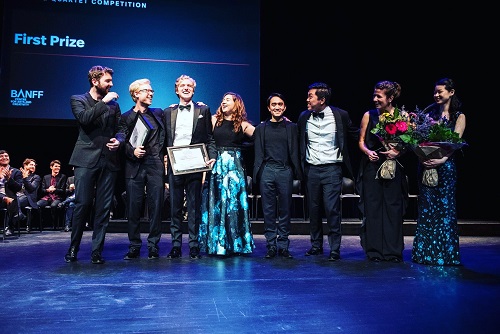 Canada BISQC 2019 [4] – Various composers: Callisto, Marmen, and Viano String Quartets, Eric Harvie Theatre, Banff Centre for Arts and Creativity, Banff, Canada, 1.9.2019. (LV)
Canada BISQC 2019 [4] – Various composers: Callisto, Marmen, and Viano String Quartets, Eric Harvie Theatre, Banff Centre for Arts and Creativity, Banff, Canada, 1.9.2019. (LV)

(c) Don Lee
Beethoven – String Quartets Op.59 Nos.2 and 3; Op.131
The three young quartets that made it to the finals of the Banff International String Quartet Competition first had to make the preliminary cut down to ten, from a field of more than 40 applicants. They then faced each other through the Haydn, Romantic, Schubert, and Canadian Commission rounds — the latter with composer Matthew Whittall’s Bright Ferment. But in the end, had it been my competition, I would have had them all play the final Beethoven round.
The finalists made a starry trio. From the United States came the Callisto String Quartet, just beginning their graduate residency at the Shepherd School at Rice University in Houston, TX. From the UK, the Marmen players were led by a Swede from Malmö, and are the current holders of the Guildhall School of Music String Quartet Fellowship. And from Canada and the U.S., the Viano were led by the recent winner of the Concours Musical International de Montréal and are in residence at the Colburn School in Los Angeles. On the afternoon of the finals, the latter two stood out.
Throughout Op.131 the Marmen Quartet’s performance felt improvised. The first violinist seemed to be carefully monitoring the flow, alongside whatever thoughts were also going through his head. As if entranced, they wandered through the theme and variations movement, got burned by a blistering Presto, and left the audience with the feeling that they had been simultaneously experiencing the score, which they knew and loved, yet played with a fresh, new, engrossing narrative. They were cheered until they returned for a curtain call.
In Op.59 No.3 from the Viano’s, the charismatic young virtuoso Hao Zhou led an Olympian reading that found a polished sexuality that softened the quirky rhythmic accents of the first movement. They smoothed over the enigma of the Andante con moto, and deigned the racehorse aspects of the Allegro molto in favor of something broader but still incomparably virtuosic. It was as if they had apprehended and brought together the various unities of sound, speed and shape that enabled us to hear and understand what Beethoven wanted. The audience cheered again and again.
After an agonizing wait of more than two hours, the Marmen and Viano Quartets were proclaimed co-winners. They will jointly share cash, three years of artistic and career development programs — including international concert tours and activities at Banff Centre — plus the newly created Southern Methodist University Peak Fellowship Ensemble-in-Residence Prize, and the St. Lawrence String Quartet Prize at Stanford University.
But I could not help thinking about the other seven quartets assembled onstage for the presentation, all of whom had contributed so much in the previous rounds to the thrills and spills of the competition.
The Agate played Debussy with the finesse and honesty that reminded you why French quartets are so prized in the repertoire. The Eliot found a uniquely personalized intimacy in Schubert’s ‘Death and the Maiden,’ and found links between double fugues in Haydn and Szymanowski. The Elmire threw themselves valiantly into Dutilleux’s Ainsi la nuit with Joel Kronisck in the audience — cellist of the Juilliard Quartet when they championed it 40 years ago.
The Omer Quartet breathed exhilarating life into Brahms Op.67, followed by a touching Adagio from the first of Schumann’s Op.41 quartets. The Ruisi Quartet painted three of their countryman Henry Purcell’s Fantasias in Four Parts in vibrato-less shades of black and white, before delicately dissecting Stravinsky’s Three Pieces. The Vera excelled in both their Haydn and Schubert rounds, and their ‘Death and the Maiden’ movement had a rare integrity and consistency.
Underlining the depth of the field, the Ulysses, who gave a consistently smooth, beautiful performance of Schubert’s D887 followed by touching Shostakovich and Pavel Haas, were heading for the Big Apple to start their new residency at the Juilliard School.
Laurence Vittes